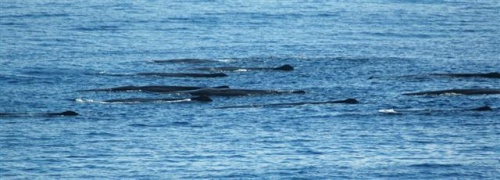Kermadecs Whales and Dolphins
The Kermadec region is an ocean highway for marine mammals making their seasonal journeys between the tropics and cooler waters around New Zealand and other southern islands. Thirty-five of the 55 whale and dolphin species recorded within the New Zealand Exclusive Economic Zone are thought to migrate through Kermadec waters and some may breed here.
SPERM WHALES
The high-productivity Kermadec Trench zone is an attractive habitat for deep-diving species such as sperm whales and beaked whales[1]. These toothed whale species are predominantly squid-eaters that forage in deep-water zones. Sperm whale records are numerous, suggesting it may be a regional hotspot for the species. Whaling logbooks dating from the 1820s–40s, and covering waters to the southeast of the Kermadec Islands, show sperm whales were extensively hunted in the area at that time[2].
In contrast to the more obvious surface behaviour of sperm whales, pygmy and dwarf sperm whales are known to be boat-shy, and so they’re rarely seen at sea. It is highly probably they exist here as they are known from Northern New Zealand and New Caledonia and from other productive trench zones.
BEAKED WHALES
Beaked whales (belonging to the genus Mesoplodon) are the second most diverse cetacean family after the dolphins, and New Zealand has the most diverse beaked whale fauna of any country. Members of this family of deep-diving animals are likely to take advantage of the Kermadec Trench zone and seamount areas. Species distributions for many are poorly known and are often based solely on records of stranded animals. Cuvier’s beaked whale is the most widespread species, and is known from northern New Zealand, New Caledonia and the Cook Islands. This species, and the more tropical Blainville’s (or dense) beaked whale, are the two most likely members of the family to frequent Kermadec waters.
Direct observations have been made of Shepherd’s beaked whales from the Three Kings region in New Zealand[3]. These and southern bottlenose whales, along with various species of mesoplodont whales such as Gray’s beaked whale, Andrew’s beaked whale and strap-toothed whale, have been recorded from whale-stranding incidents from the far north of New Zealand[4]. It is possible that they may also range widely enough to be found here.
DOLPHINS
Dolphin species reported from direct observations in the region are the orca or killer whale, common dolphin, bottlenose dolphin and long-finned pilot whale, with possible sightings of striped dolphin. An observation of Fraser’s dolphin north of New Zealand in 2004[5] suggests the likely presence of the species in the area. Other more tropical delphinids that venture into New Zealand waters and are known from New Caledonia and Tonga are also very likely to be represented. These include Risso’s dolphin, melon-headed whale, spotted dolphin, spinner dolphin, false-killer whale and short-finned pilot whale. One species likely to occur, but that has not as yet come as far south as New Zealand, is the pygmy killer whale; records of this species in both Tonga and New Caledonia suggests it will also be present in the Kermadec region.
SOUTHERN RIGHT WHALES
Whaling logbooks indicate that the waters southeast of the Kermadec Islands were also an important area for southern right whales, and observed behaviours suggest they may have bred here[6]. Little data is available on modern distributions of the species because it was hunted to near extinction, and recovery rates appear to have been extremely slow. There have been two reports of southern right whales from Raoul Island by DOC staff, but with historic sightings as far north as 27°S[7], these are among the most northerly reports of this species.
HUMPBACK AND OTHER BALEEN WHALES
Observations from the 1970s to 2007[8] show the humpback is the most frequently seen baleen whale in the Kermadec area. This may, however, simply reflect the visibility of their surface behaviour and ease of identification rather than real numbers. Unpublished data from satellite tags show that the Kermadecs may be an important ‘staging post’ for humpback whales in their southerly migration[9]. At least two mother and calf pairs have been observed and photographed here[10], and another mother and calf pair observed separately at Denham Bay, Raoul Island[11].
The larger southern ocean baleen whale species may well also pass through Kermadec waters, as indicated by a record of a blue whale stranding at Raoul Island[12], although there are no direct observations of pygmy blue whale, sei whale, Bryde’s whale, fin whale or Omura’s whale.
Both Antarctic and dwarf minke whales have been recorded from New Caledonia, Tonga and New Zealand, and are also likely to be present in the Kermadec region.
 Photo: Karen Baird
Photo: Karen BairdSperm whales off Raoul Island.
[1] Arnold 2004
[2] Richards 2002; Townsend 1935
[3] D. Donnelly, pers. comm.
[4] New Zealand Whale Stranding Database
[5] A.N. Baker, pers. comm.
[6] Richards 2002; Townsend 1935
[7] R. Richards, pers. comm. 2007
[8] Gaskin, Baird & Jenkins, unpublished data
[9] K. Baird, pers. comm.
[10] M. Francis, pers. comm.; C. Gaskin, pers. comm.
[11] Moreton 1957
[12] Moreton 1957












